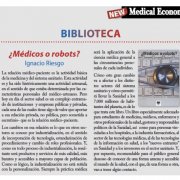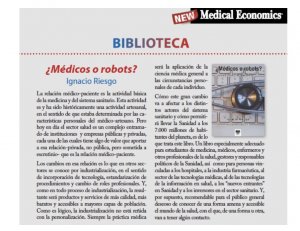
On January 31, 2022, in the Ernest Lluch room of the Congress of Deputies, the document 20 years of the culmination of the process of health transfers in Spain was presented, a document in which prestigious protagonists of the transfers and other analysts participated. The book was sponsored by AstraZeneca and produced by BioInnova.
I had the honor of participating in said book with a chapter entitled Healthcare transfers to the regions: a problem without governance of the National Health System, which appears below
PDF of the article:
20añoslibro-IgnacioRiesgo
Healthcare transfers to the regions: a problem without governance of the National Health System
Health transfers: a long distance race with a final sprint
The first transfers of health care from the Social Security (INSALUD) took place in Catalonia in 1981, therefore during the UCD period in government and before the General Health Law (1986). The global transfer process lasted more than twenty years, although there were two well-differentiated periods, the first, between 1981 and 1994, in which seven communities received INSALUD transfers: Catalonia, Andalusia, the Basque Country, the Valencian Community, Galicia, Navarra and the Canary Islands, in this order. The conclusion was in 2002, with transfers to the remaining ten communities.
The first seven transfers were made in a long span of thirteen years, the last ten in a final sprint of eleven months.
Before the transfers of INSALUD services, surely because they were easier as they hardly had any resources, those of Public Health had been carried out, despite being the most debatable conceptually. The coronavirus pandemic has shown us the limitations of this improvised process.
Always, as it could not possibly be otherwise in such a complex process, the motivation and impetus for the transfers was of general policy and not so much for health reasons. Let us think, as an example, of how important the referendum in Andalusia in 1980 was, which in practice blurred the differences between article 151 of the Constitution, initially intended for Catalonia, the Basque Country and Galicia, and article 143, for the rest of the autonomies. That referendum activated the transfers to Andalusia, made immediately after the initials to Catalonia. Or the will of President Aznar to quickly close the process of health transfers, as has been told by some of its protagonists ([1]).
There are many discussions about whether health transfers were required by the Constitution or not. Although personally I think not necessarily (at least, as it was done, to the 17 autonomous communities), this is a debate that leads nowhere.
Surely, the most important reason for the transfers is that this approach was more consistent with a State of the autonomies as it was being constituted, in which it is logical that the services be transferred.
In any case, transfers are an irreversible process. It does not seem that some statements proposing to return Public Health competencies have the slightest viability, beyond political rhetoric ([2]). Therefore, the logical approach is to try to take full advantage of its potential, minimizing some possible negative elements, of disintegration of the National Health System.
The transfers were made without previously defining cohesion instruments
What do we mean by cohesion instruments? To certain organizations (generally known as Agencies), whose basic characteristics are a certain independence from political power, a high technical and professional level, and extensive participation in their governance by key agents, all with the aim of providing support strong technical approach to certain system problems.
These types of instruments have been implemented in many countries, even in some with highly decentralized health systems.
We refer, for example, to the Agencies for quality and clinical activity ([3]); drug evaluation ([4]); public health ([5]); evaluation of medical technologies ([6]); transparency and dissemination of information ([7]); promotion of e-health ([8]); promotion of patients’ interests ([9]); etc.
The Law of cohesion and quality in 2003, after having completed the transfer process, therefore a posteriori, wanted to address the problem of cohesion. But it did so with some instruments (service portfolio, comprehensive plans, High Inspection) that proved ineffective. Regarding the portfolio of services, an independent Agency was not added to guarantee its updating; comprehensive plans, while interesting, are of limited effect; and, as for the High Inspection, from the beginning it was not a useful instrument, given its rejection by the autonomous communities.
The main problem: the absence of a definition of what are and what are not attributes of the National Health System
It must be taken into account that health transfers are not only an administrative decentralization, but a political “devolution” ([10]), which means that communities must be able to define their own priorities and how to achieve them.
This means that uniformity is not a value of the National Health System, rather the opposite, diversity is a value.
Now, for it to be truly a System, as defined, and not a set of systems, the National Health System must have some common attributes, on which little thought has been given. Even without a rigorous legal analysis, we consider common attributes of the National Health System:
- Universal coverage
- Public funding
- The common service portfolio
- The mobility of professionals, which implies common training aspects
- Some elements (not all) of the care model, such as the operation of primary care as a gateway to the system
- Since the services must be open to the entire population throughout the territory, the sharing of certain clinical information, such as medical records, unless you want to do “anonymous medicine”.
- Likewise, the implication in certain common decisions of the National Health System, what has now been called “co-governance”.
If all this is common, what is left to the powers of the autonomous communities? Many things: whether or not to prioritize health in the public budget, beyond a minimum that guarantees compliance with the portfolio of services; the portfolio itself, adding or not benefits to the common portfolio; the management model (from this perspective, the intention of the Ministry of Health to declare direct public management as “preferential”, included in the Preliminary Bill of Equity, Universality and Cohesion, in process when these lines are written, seems to us an attack on the powers of the autonomous communities); many aspects of personnel policy (remuneration framework, incentives, professional categories, selection and evaluation process, etc.); elements of the healthcare model itself; relations with the private sector, etc.
What is important is to be clear about the rules of the game.
Transfers and dissolution of INSALUD
It is not only that health services were transferred simultaneously to the ten communities that had not yet received them, it is that INSALUD was also dissolved.
With all its possible flaws, INSALUD was an important technical buffer. These functions were not replaced by anyone, since the Carlos III Health Institute, which could have assumed these functions, never did, beyond supporting research; and the Ministry of Health, very limited in its capacities, was never a technical body, but rather a political one.
Thus, the transfers were made without the communities having a technical body of reference, which is all the more serious since the majority of the communities that received the transfers had less than two million inhabitants and their administrations were under construction, with which its capacity to set up highly qualified technical bodies was more than limited.
Thus, the transferred health services were left to the exclusive discretion of a political leadership, not always aware of the complexities of the health world, which acted without technical checks and balances, an ideal breeding ground for all kinds of errors and wrong decisions.
Positive and negative effects of transfers
Before we get into these topics, we should mention what we don’t think are transfer issues. Sometimes the great differences in health financing of the autonomous communities or the inequities in resources, results and access as a consequence of the transfers are adduced. Nothing more uncertain. These problems were already there before the transfers and it does not seem that they have aggravated them either ([11]).
Among the positive effects, surely a more accurate understanding of the territorial problems of health, very difficult to understand from centralized organizations, which tend to see everything from the perspective of a certain uniformity. Also an incardination of health in regional projects, very important, since health must be framed in health policies, which are intersectoral by definition.
But, along with these positive effects, the negative ones are very evident:
- We have already commented on the problems arising from the way transfers are made, without the existence of a technical support body, with the consequent dangers of this situation, due to excessive dependence on political decisions not nuanced by solvent technical support.
- There has been a clear phenomenon of centralization in the Regional Health Services, with a brake on some ongoing movements of autonomy of health organizations (public companies, foundations, etc.) that were stopped cold, accentuating the more administrative features and bureaucratic of the system. The latest unfortunate episode of these characteristics is taking place in Andalusia, where the government of the Junta is dismantling the initiatives of public hospital companies, under the pretext that they were “chiringuitos”, but that conceals a distrust in the slightest autonomy of healthcare organizations.
- A brake on reform initiatives. An unintended consequence of the transfers is that there was a parking lot for the great pending reform issues (management model, personnel regime, etc.). Let’s say that the Ministry was inhibited, since “everything was transferred” and the communities saw that as problems that did not concern them. The consequence is that many key issues are no longer on the political agenda.
- Cohesion problems, due to the lack of adequate instruments. The absence of the creation of a general information system of the National Health System; the failure of medical record interoperability; the important differences in quality and results in the different autonomous communities; and, an extreme opacity of the health system as a whole, are just a few examples.
It is good to be aware of these problems, not so much to question the transfers, which seem irreversible to us, but to lay the foundations that allow us to take advantage of their full potential, minimizing their problems and guaranteeing the attributes of the National Health System.
“Co-governance” during the pandemic, although improvised and poorly organized, offers some lessons
During the pandemic, the use of the term “co-governance” became widespread. Regardless of the use of this concept to justify the inhibition of the central government in certain decisions, the truth is that the concept has a basis of truth: the limitations of the Ministry of Health to exercise leadership alone in the National Health System, if it is not by sharing it with other organizations, institutions and groups.
The mistake is to have applied “co-governance” only with governments (those of the autonomous communities, in the Interterritorial Council) and not with the group of agents in the sector. Making a play on words, we could say that there has been “co-governance”, but not governance, as this is interpreted as the participation of the different agents.
But it must be recognized that there is truth in the concept of “co-governance” and that, well defined, it can be a solution.
The false solution of giving executive character to the Interterritorial Council of the National Health System
Faced with the problems of a totally decentralized Health System, some ([12], [13]) propose giving executive powers to the Interterritorial Council, something that it never had since it was always a coordination body, not an executive one.
We believe that the problems of the Interterritorial Council of the National Health System are not the lack of enforceability of its decisions, but rather that of “feeding” its activity with two important “inputs”: those derived from the participation of all the agents in the sector and the information and technical positions from specialized technical bodies.
Giving executive powers to the Interterritorial Council of the National Health System will surely bring more problems than solutions and seems difficult for the autonomous communities to accept.
A forum where the government shares its decisions on the National Health System with the autonomous communities and where both the central government and the autonomous communities receive the “input” from both the representation of the main agents of the system, and the technical bodies seems to us something much more effective than a theoretical “enforceability of their decisions.”
A proposal: strengthen participation and implementation of cohesion instruments
The key element to take full advantage of transfers and neutralize the problems that have been detected is to provide the National Health System as a whole with a well-defined and mature governance model, based on a much greater participation of the different agents and to provide of cohesive organs.
Regarding participation, it would be a question of modifying the composition of the Interterritorial Council of the National Health System, giving entry to it to a citizen and patient representation; as well as professionals, mainly represented by scientific societies.
As for the cohesion bodies, they should be constituted through a multi-agency system, model AIReF (Independent Fiscal Responsibility Agency). At least the following:
- Information, Evaluation and Quality Agency
- Public Health Agency
- Agency for digital transformation
This approach would make it possible to resume a reformist agenda, fundamentally in the two major issues forgotten in the General Health Law: the management model, so that health institutions move towards a more businesslike and less administrative operation; and the personnel system, in order to overcome the rigid statutory model and gradually set up more flexible forms of relationship between professionals and the system.ties
[1] Statements by Rubén Moreno, “Lights and shadows of transferences: 15 years later”, El Médico Interactivo, 3/22/2017, https://elmedicointeractivo.com/luces-sombras-transferencias-sanitarias-15-anos -after-20170322125517110945/ (accessed December 9, 2021)
[2] Vara proposes that the regions return public health competencies to the Government
El Periódico de Extremadura, 10/17/2014, https://www.elperiodicoextremadura.com/extremadura/2014/10/10/vara-propone-regiones-devolven-competencias-44585804.amp.html (accessed December 9, 2021 )
[3] Care Quality Commission, in the United Kingdom; National Agency for Quality Assessment in health and social organizations, in France; Institute for Quality and Efficiency, in Germany; National Institute for Health, in the Netherlands; Agency for Health and Social Services, in Sweden
[4] NICE, in the United Kingdom; Drug Evaluation Council, in the Netherlands; the Agency for Medicines, in Norway; the Agency for Medicines and Dental Products, in Sweden
[5] Public Health Agency, in France; the National Institute of Public Health, in Italy; the Norwegian Institute of Public Health, in Norway
[6] Agency for Medical Products, in Sweden
[7] Agency for information on hospital care, in France; the Institute for Quality and Transparency, in Germany
[8] ASIP Santé, in France; the Swedish Agency for e-health, in Sweden
[9] Healthwatch England, in the United Kingdom
[10] “Devolution” is the term used for this type of transfer to territorial entities with political autonomy.
[11] López-Casasnovas, G, Rico, A
Decentralization, part of the health problem or its solution?
Gac Health 2003; 17(4):319-26
[12] Martínez García, JM
Lights and shadows of the current health decentralization in Spain
Giménez Abad Foundation, June 26, 2019
https://www.fundacionmgimenezabad.es/es/luces-y-sombras-de-la-actual-descentralizacion-sanitaria-en-espana (accessed December 10, 2021)
[13] Appearance of the Collegiate Medical Organization in the Commission for Social and Economic Reconstruction of the Congress of Deputies, 6/2/2020
https://www.congreso.es/docu/comisions/reconstruccion/informes_comparecientes/390_20200602_DC_Sr_Romero_Aguit.pdf, (accessed December 10, 2021)














